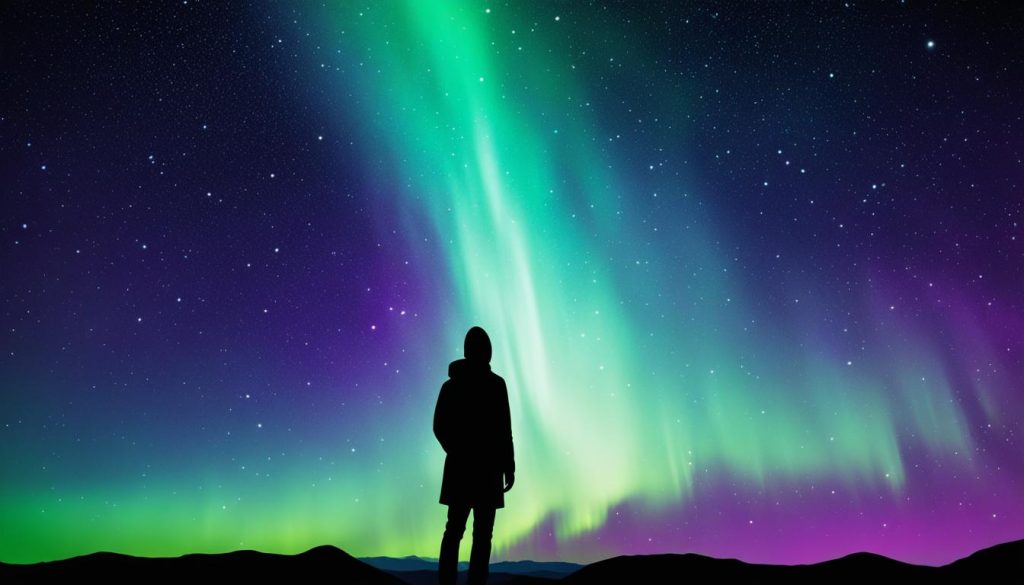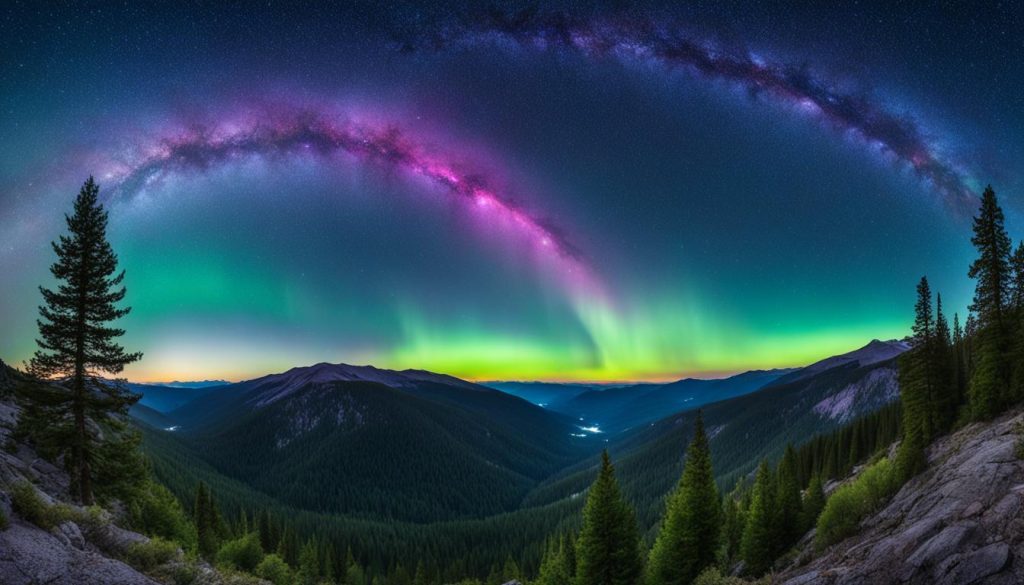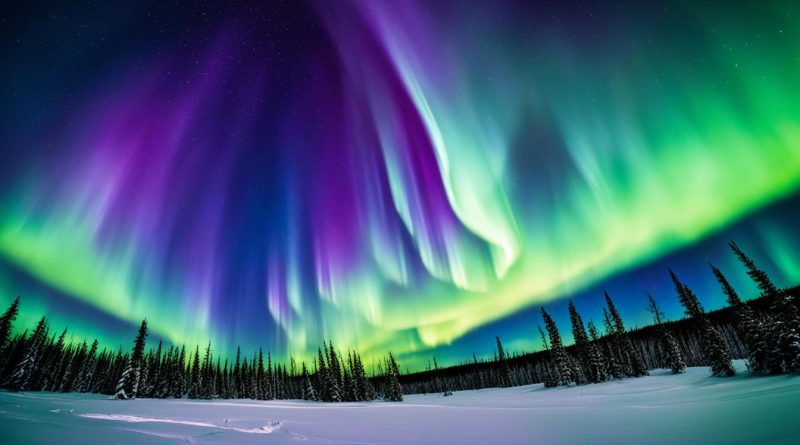Aurora Forecast: Predict Northern Lights Sightings
The aurora borealis, or Northern Lights, is a stunning natural wonder. It has amazed people all over the world. Seeing the lights dance in the sky is a dream for many. But, knowing when and where to see them can be tricky.
This guide will dive into the science of the Northern Lights. We’ll also share top resources to help plan your aurora viewing trip.
Key Takeaways
- Understand the origins and science behind the aurora borealis phenomenon
- Discover the key factors that influence aurora visibility and how to track them
- Learn about the most reliable sources for real-time aurora forecasts and alerts
- Interpret aurora forecast maps and data to plan your Northern Lights viewing
- Explore the best locations for aurora sightings and photography tips
Understanding the Aurora Borealis Phenomenon
The aurora borealis, or Northern Lights, is a stunning light show in the sky. It happens when the Sun, Earth’s magnetic field, and atmosphere work together. Learning about the science behind it helps us enjoy its beauty more.
Origins and Science Behind the Northern Lights
The aurora borealis starts when the Earth’s magnetic field meets charged particles from the Sun, known as the solar wind. These particles hit gas molecules in the atmosphere, making them glow. The colors we see depend on the gas molecule type. Oxygen makes green and red, while nitrogen creates blue and purple.
This light show is mostly seen near the Earth’s magnetic poles. The charged particles move towards the poles, creating a beautiful display for us to see from the ground.
The aurora borealis gets more intense when the Sun is active. Solar flares and coronal mass ejections send more charged particles towards Earth. This means we see more and brighter Northern Lights during these times.
Learning about the aurora borealis and its science lets us enjoy its beauty more. It also shows us how the Sun, Earth’s magnetic field, and atmosphere interact.
Factors Influencing Aurora Visibility
Seeing the aurora borealis, or Northern Lights, is a magical experience. But, many things can change how well you can see it. Knowing these factors helps plan the best times to see the aurora.
Solar activity is a big factor in seeing the aurora. The Sun goes through a cycle every 11 years, changing its activity. When the Sun is more active, it sends out particles that make the auroras brighter and more visible.
Weather also matters a lot. You need clear skies to see the Northern Lights. Clouds or rain can block your view, even if the auroras are active. Checking the weather forecast can help pick the best nights for viewing.
- Where you are also affects how well you can see the aurora. The best locations are usually near the Earth’s magnetic poles. This is where the auroral oval is, and auroras happen most often.
- The time of year also plays a part. In places with more darkness in the winter, you’re more likely to see the Northern Lights.
Knowing what affects the aurora can help you see this amazing natural light show.
Reliable Sources for Aurora Forecast
Knowing when and where to see the Northern Lights is key for a great viewing experience. Luckily, there are many trusted websites and apps that give accurate and up-to-date forecasts. These tools help you plan your Northern Lights adventure.
Trusted Websites and Apps for Accurate Predictions
Here are some top sources for aurora borealis forecasts:
- NOAA’s Aurora Forecast – NOAA provides detailed forecasts on solar activity and Northern Lights visibility.
- Aurora Service Europe – This site specializes in forecasting the Northern Lights in Europe and North America. It offers predictions, maps, and live updates.
- Aurora Forecast.com – This website is easy to use and great for aurora enthusiasts. It provides clear data on the Northern Lights.
- Icelandic Met Office – If you’re heading to Iceland to see the Northern Lights, the Met Office offers reliable forecasts and updates.
There are also mobile apps like Aurora Borealis Forecast and My Aurora Forecast. These apps send push notifications and alerts for the best times to see the Northern Lights.
| Website | Description | URL |
|---|---|---|
| NOAA’s Aurora Forecast | Comprehensive aurora forecast service from the National Oceanic and Atmospheric Administration | https://www.noaa.gov/aurora-forecast |
| Aurora Service Europe | Specialized website for aurora borealis forecasting in Europe and North America | https://www.aurora-service.eu/ |
| Aurora Forecast.com | User-friendly website with detailed aurora borealis predictions and data | https://www.aurora-forecast.com/ |
| Icelandic Met Office | Reliable aurora forecasts and real-time information for Iceland | https://en.vedur.is/weather/articles/nr/3232 |
Reading Aurora Forecast Maps and Data
Learning how to read aurora forecast maps is key to knowing when and where to see the Northern Lights. By understanding the Kp index and Ovation Auroral models, you can plan your aurora viewing trips better.
Interpreting Kp Indices and Ovation Auroral Models
The Kp index shows how active the Earth’s magnetic field is, from 0 (quiet) to 9 (extreme). A higher Kp means a better chance of seeing the aurora, especially when it’s 5 or above. Ovation Auroral models show where the aurora might be most visible, helping you find the best spots.
| Kp Index | Aurora Visibility |
|---|---|
| 0-4 | Low to moderate |
| 5-7 | High |
| 8-9 | Extreme |
Knowing how to read aurora forecast maps helps you plan better for Northern Lights viewing. Stay tuned for more tips on where and how to capture the beautiful aurora borealis.
Best Locations for Northern Lights Viewing
The aurora borealis, or northern lights, can be seen in many places around the world. But some spots are better for viewing because of their geography and weather. Alaska and Norway have some of the best places to see the northern lights.
Alaska is a top spot for seeing the northern lights. It’s far north and has clear skies, perfect for viewing. Places like Fairbanks, Chena Hot Springs, and Denali National Park are known for great northern lights shows.
| Location | Average Visibility | Unique Factors |
|---|---|---|
| Fairbanks, Alaska | 225 days per year | Clear skies, high latitude |
| Tromsø, Norway | 200 days per year | Coastal location, fjords |
| Yellowknife, Canada | 240 days per year | Remote location, minimal light pollution |
Tromsø, Norway, is another great place to see the northern lights. It’s by the coast with beautiful fjords. The weather is stable and it’s far north, making it a favorite spot for viewing the lights.
Yellowknife in Canada is perfect for a quiet northern lights experience. It’s far from cities and has little light pollution. This means you can see the northern lights very clearly.
Choosing the right spot to see the northern lights is important. You need to be patient and ready for changing weather. Use tips and guides to help you see this amazing sight.
Aurora Forecast for Tonight

As the sun sets and night comes, people look forward to seeing the northern lights. The aurora forecast for tonight is key to enjoying this natural wonder. It gives updates and predictions to help plan your viewing.
Real-Time Updates and Predictions
It’s important to keep an eye on the latest aurora activity and aurora borealis forecast. Sources like the Aurora Service and NOAA’s Space Weather Prediction Center provide updates. They tell you about the aurora borealis live forecast and chances of aurora sightings tonight.
| Forecast Service | Kp Index Range | Visibility Likelihood |
|---|---|---|
| Aurora Service | Kp 4-6 | High chance of visible aurora |
| NOAA Space Weather | Kp 5-7 | Very high chance of visible aurora |
By watching these aurora forecast sources, you can stay updated. This helps you plan your aurora viewing plans better. With updates on the aurora borealis forecast now, you can increase your chances of seeing the northern lights.
aurora forecast
Aurora forecasts come in different time frames to help plan your viewing. You can find forecasts from 30-minute to 30-day time frames. Each one gives unique insights for those wanting to see the Northern Lights.
The 30-minute aurora forecast updates you on the current activity and visibility of the Northern Lights. It’s great for making last-minute decisions about going out to see the show. The aurora 30 minute forecast is perfect for those wanting to see the aurora borealis on a specific night.
The 3-day and 7-day aurora forecast offer a longer view. They tell you when the next big storm might happen and if the skies will be clear for viewing. These forecasts look at solar activity, weather, and geomagnetic conditions to find the best times to see the aurora.
The 30-day aurora forecast gives a broader view of the upcoming aurora season. It helps travelers plan their trips during the most active times. The aurora forecast 30 day is essential for those wanting to see the amazing natural display.
Staying updated with the latest aurora forecast 10 days, aurora forecast 14 days, and aurora forecast hourly can really improve your chances of seeing the Northern Lights. With these tools, aurora chasers can plan their next viewing with confidence.
Photography Tips for Capturing the Northern Lights

Photographing the aurora borealis, or Northern Lights, is a captivating experience. It’s key to know the best camera settings and techniques. These northern lights photography tips are great for both experts and beginners. They help you take amazing shots that show the beauty of the aurora.
Camera Settings and Techniques for Stunning Shots
To photograph the northern lights well, keep these settings and techniques in mind:
- Exposure Time: Use a long exposure, 10-30 seconds, to catch the aurora’s movement and intensity.
- Aperture: Set your aperture wide, like f/2.8 or f/4, to let more light in.
- ISO: Boost your ISO to 800-3200 to make up for the low light.
- Tripod: A strong tripod helps avoid camera shake and gets you sharp images.
- Composition: Try different framing, like adding foreground elements or reflecting the aurora in water.
With these northern lights photography techniques, you’re set to capture the best camera settings for aurora borealis. You’ll make images that show the Northern Lights’ beauty.
Planning an Aurora Viewing Adventure
Seeing the northern lights, also known as the aurora borealis, is a dream for many travelers. To plan a successful aurora viewing trip, you need to think about a few important things. We’ll help you pick the best spot, pack what you need, and make sure you have a great time.
Selecting the Ideal Destination
Choosing the right place to see the northern lights is the first step. The best spots are usually in high-latitude areas like Alaska, Northern Canada, Iceland, Scandinavia, and parts of Russia. Think about weather, light pollution, and how easy it is to get there to see the lights.
Packing the Essentials
Getting ready for your northern lights viewing adventure means packing the right gear. Wear warm clothes for the cold weather. Get good winter boots, gloves, and a hat for comfort. And don’t forget your camera and tripod to capture the lights.
Maximizing Your Viewing Experience
To enjoy your northern lights vacation planning, pick a spot with little light pollution. This lets you see the lights better. Also, be ready to move around to find the best views. Keep an eye on the aurora forecast to catch the lights at their best.
| Destination | Best Season | Viewing Conditions |
|---|---|---|
| Alaska, USA | September to April | High latitude, clear skies, low light pollution |
| Yukon, Canada | August to April | High latitude, dry climate, minimal light pollution |
| Lapland, Finland | September to March | High latitude, snowy landscapes, low light pollution |
Follow these tips and get ready for your northern lights viewing adventure. Stay flexible, watch the forecast, and enjoy the hunt for this amazing sight.
Conclusion
This article has given a full guide on understanding and predicting the amazing aurora borealis. We’ve looked into the science behind the Northern Lights. We’ve also talked about what affects their visibility and the best ways to get real-time forecasts.
Now, readers know how to plan and enjoy an aurora viewing trip. The article showed why it’s key to stay informed and ready to see this natural wonder. We learned about the Kp indices and how to pick the best spots for viewing.
Thanks to trusted websites and apps, aurora fans can keep up with the latest forecasts. This helps them make the most of their chances to see the Northern Lights.
As we wrap up, it’s clear the aurora borealis is a stunning and amazing natural event. With the knowledge and tools from this article, we can go on unforgettable trips. We can capture the beauty of the aurora borealis and make memories to share with others.

